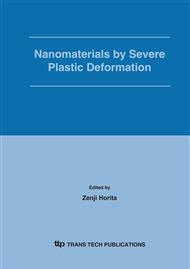p.77
p.83
p.91
p.99
p.107
p.113
p.119
p.125
p.133
Influence of Cu on the Mechanical Properties of an Al-4.4wt%Mg Alloy after ECAP
Abstract:
Two Aluminium alloys, type AA5182 and AA5182+1.2wt% Cu, have been studied. The second alloy in solution treated condition is 18% stronger than the first one. During ageing at 150°C or 200°C it shows a characteristic fast increase in yield strength during the first minutes of ageing, followed by a 'plateau'. Both materials have been deformed in an ECAP die (4 and 8 passes) at 200°C and the microstructure, hardness and mechanical properties in compression at room temperature have been investigated. Although in none of the two materials a true sub-micron grain size was obtained at 200°C, a fair combination of strength and strain hardening was observed. The AA5182+Cu alloy, when ECAP’ed after a solution treatment and quenching, shows an increase in strength of about 20% compared to the AA5182 reference alloy. A post-ECAP annealing at 200°C does not lead to a further increase in hardness or strength. An analysis of the substructure and the mechanical properties during ECAP led to the conclusion that the precipitates formed during ECAP at 200°C do not directly contribute to the higher strength of alloy AA5182+Cu, but they contribute indirectly by slowing down the recovery.
Info:
Periodical:
Pages:
107-112
Citation:
Online since:
January 2006
Authors:
Price:
Сopyright:
© 2006 Trans Tech Publications Ltd. All Rights Reserved
Share:
Citation:


